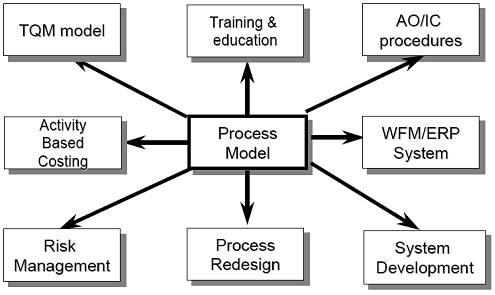At level four we have landed at the core: the business processes themselves.
A process has the following characteristics:
-
it always has a trigger,
-
is a logical sequence of activities that have to be carried out
-
and creates output (product/service) for an internal or external customer.
For instance, the input of a sales process might be a request from a client. The output might be a booking. The
activities within a process describe how the 'input' is transformed into an 'output'. In our example, the activities
will describe how the client request is translated into a completed booking.
A Business Process is a process that takes place in a (commercial) business, as opposed for instance to chemical or
biological processes.
A Business Process Model is a formal description of the various components of a Business Process. One way to describe a
Business Process is by drawing a flowchart that shows the chronological sequence of the business activities. Besides
activities, a Business Process Model can contain additional information such as who performs the activities, who is
responsible, who is involved, what documents or computer programs are used and how much time each activity takes to
complete.
In order to make the right distinction which activities have to be distinguished within a process, we use the OTOPOP
principle. The OTOPOP principle implicates that an activity is performed in One Time (continuous flow), at One Place
and by One Person. Be sure that each Future Process Activity Has Intrinsic Value.
To be complete: within activities one can distinguish actions as the most elementary units.
As mentioned before, depending on the actual use of the model, a number of attributes might have to be added to these
items or there might be some additional requirements about the structure of the process model. Without being complete,
one can think of the following reasons for process modelling:

Each purpose can be supported by process modelled in a different way, but also requires the registration of different
information about the process (activities). E.g.:
-
Administrative Organizations often have a large number of procedures which can be quite complex. In the ideal
situation, these procedures should be derived from the processes. A process model can be useful in attempting to
simplify the processes and the procedures of such an organization. It can also be used as a manual to ensure that
procedures are performed correctly. Internal control is defined as a process, effected by an entity's board of
directors/trustees, management and other personnel, designed to provide reasonable assurance regarding the
achievement of objectives in the following categories:
-
Effectiveness and efficiency of operations.
-
Reliability of financial reporting.
-
Compliance with laws and regulations.
Internal control is often linked with the processes of an administrative organization. This explains the fact that
this domain is often labeled AO/IC (administrative organization and internal control).
-
The aim of Total Quality Management is that of incorporating a continuous improvement in business processes. This
is often achieved by a control loop in which check and improvement activities are incorporated. BPM can help
determine where these loops are in place, and where they are still missing. Performance Indicators are related to
TQM. They consist of measurements of the outputs of processes, sub-processes and activities. Performance Indicators
can help control the quality of the process results. A process model is a good starting point to determine which
Performance Indicators will be the most effective.
-
Risk Management helps to acquire a better control of risks. This is done by determining the risks which are
inherent to a process and by analyzing the probabilities and impacts of these risks. A process model can help to
systematically detect the potential risks which are inherent in a process.
-
Simulation studies are mostly used as part of a process improvement or redesign project. They can help to validate
a process by analyzing measurable quantities such as resource availability, throughput times and buffer usage.
Simulations can help resolve inconsistencies and bottlenecks and usually lead to a better understanding of complex
processes. For a simulation to deliver reliable results, the simulation model should reflect the actual processes
as accurately as possible. It is therefore essential that a good process model be used as a basis for simulation
studies.
|

